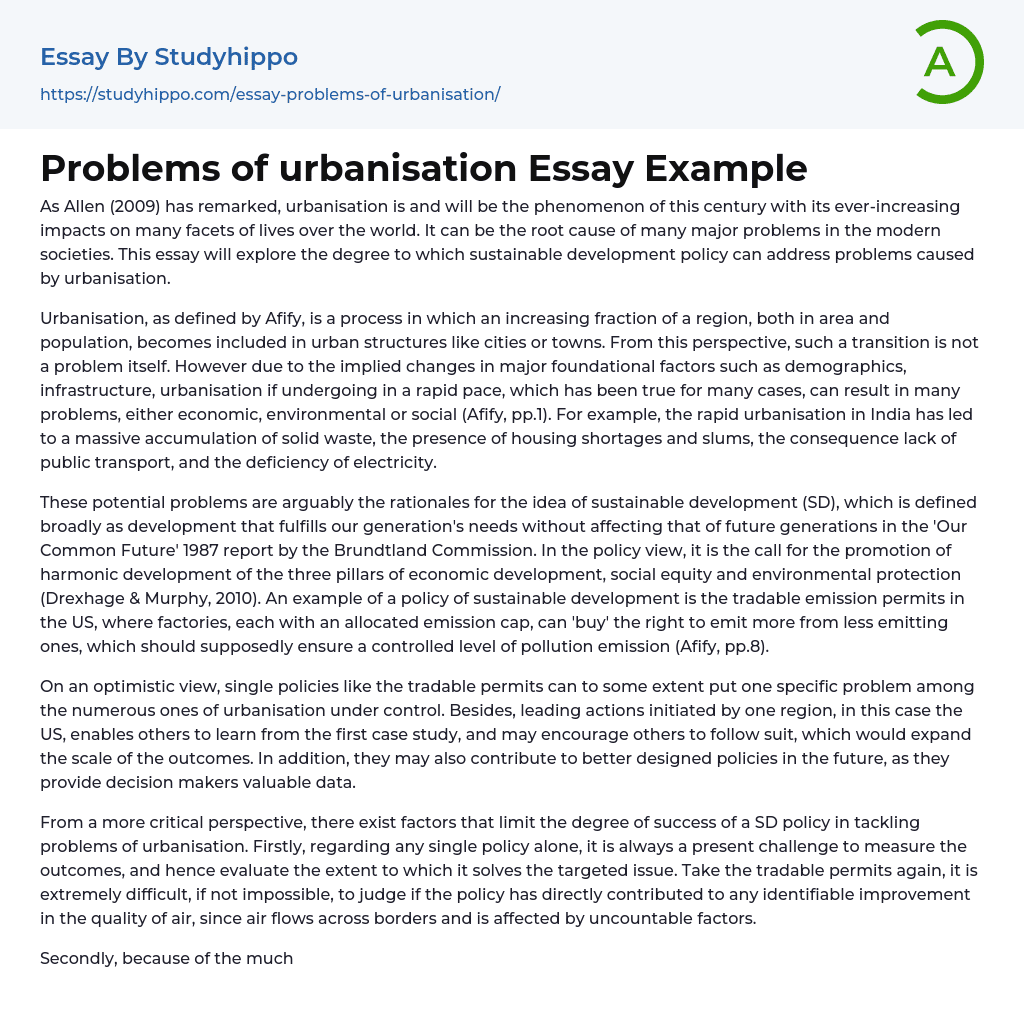As Allen (2009) has remarked, urbanisation is and will be the phenomenon of this century with its ever-increasing impacts on many facets of lives over the world. It can be the root cause of many major problems in the modern societies. This essay will explore the degree to which sustainable development policy can address problems caused by urbanisation.
Urbanisation, as defined by Afify, is a process in which an increasing fraction of a region, both in area and population, becomes included in urban structures like cities or towns. From this perspective, such a transition is not a problem itself. However due to the implied changes in major foundational factors such as demographics, infrastructure, urbanisation if undergoing in a rapid pace, which has been true for many cases, can result in many problems, either economic, environmental or so
...cial (Afify, pp.1). For example, the rapid urbanisation in India has led to a massive accumulation of solid waste, the presence of housing shortages and slums, the consequence lack of public transport, and the deficiency of electricity.
These potential problems are arguably the rationales for the idea of sustainable development (SD), which is defined broadly as development that fulfills our generation's needs without affecting that of future generations in the 'Our Common Future' 1987 report by the Brundtland Commission. In the policy view, it is the call for the promotion of harmonic development of the three pillars of economic development, social equity and environmental protection (Drexhage & Murphy, 2010). An example of a policy of sustainable development is the tradable emission permits in the US, where factories, each with an allocated emission cap, can 'buy'
the right to emit more from less emitting ones, which should supposedly ensure a controlled level of pollution emission (Afify, pp.8).
On an optimistic view, single policies like the tradable permits can to some extent put one specific problem among the numerous ones of urbanisation under control. Besides, leading actions initiated by one region, in this case the US, enables others to learn from the first case study, and may encourage others to follow suit, which would expand the scale of the outcomes. In addition, they may also contribute to better designed policies in the future, as they provide decision makers valuable data.
From a more critical perspective, there exist factors that limit the degree of success of a SD policy in tackling problems of urbanisation. Firstly, regarding any single policy alone, it is always a present challenge to measure the outcomes, and hence evaluate the extent to which it solves the targeted issue. Take the tradable permits again, it is extremely difficult, if not impossible, to judge if the policy has directly contributed to any identifiable improvement in the quality of air, since air flows across borders and is affected by uncountable factors.
Secondly, because of the much higher degree of interlinkages between the three pillars, economics, social and environmental, within urbanised areas, a single policy will unlikely achieve desired outcomes without the systemic introduction of a series of policies designed to compliment each other by addressing each pillar. Thirdly, because of this requirement of systemic changes in policies, it necessitates a long-term view regarding the time frame required to design and establish the policies, which in many cases conflict with
short-term policy interests.
In conclusion, the problems of (rapid) urbanisation are real and inevitable. Sustainable development is a policy approach that is increasingly adopted and recognised. However introducing policies under the label 'sustainable development' does not necessarily imply serious effort is being committed and effective outcomes are being produced, due to the problems outlined above. It is worth noting that due to limited capacity, this short essay has barely scratched the surface of the topic, and there is much depth to be explored for a better understanding.
- Air Pollution essays
- Carbon Dioxide essays
- Climate essays
- Deforestation essays
- Ecology essays
- Endangered Species essays
- Environmental Issues essays
- Environmental Protection essays
- flood essays
- Greenhouse Gas essays
- Hurricane essays
- Nature essays
- Pollution essays
- Renewable Energy essays
- Sustainability essays
- Tornado essays
- Traffic essays
- Tsunami essays
- Water Pollution essays
- Accident essays
- Awareness essays
- Benefits of Volunteering essays
- Challenges essays
- Childhood Memories essays
- Decision essays
- Driving essays
- Event essays
- Excellence essays
- Expectations essays
- Failure essays
- Farewell essays
- Flight essays
- Gift essays
- Growing Up essays
- Ignorance essays
- Improve essays
- Incident essays
- Knowledge essays
- Luck essays
- Memories essays
- Mistake essays
- Obstacles essays
- Overcoming Challenges essays
- Party essays
- Peace Corps essays
- Personal Experience essays
- Problems essays
- Sacrifices essays
- Struggle essays
- Success essays




